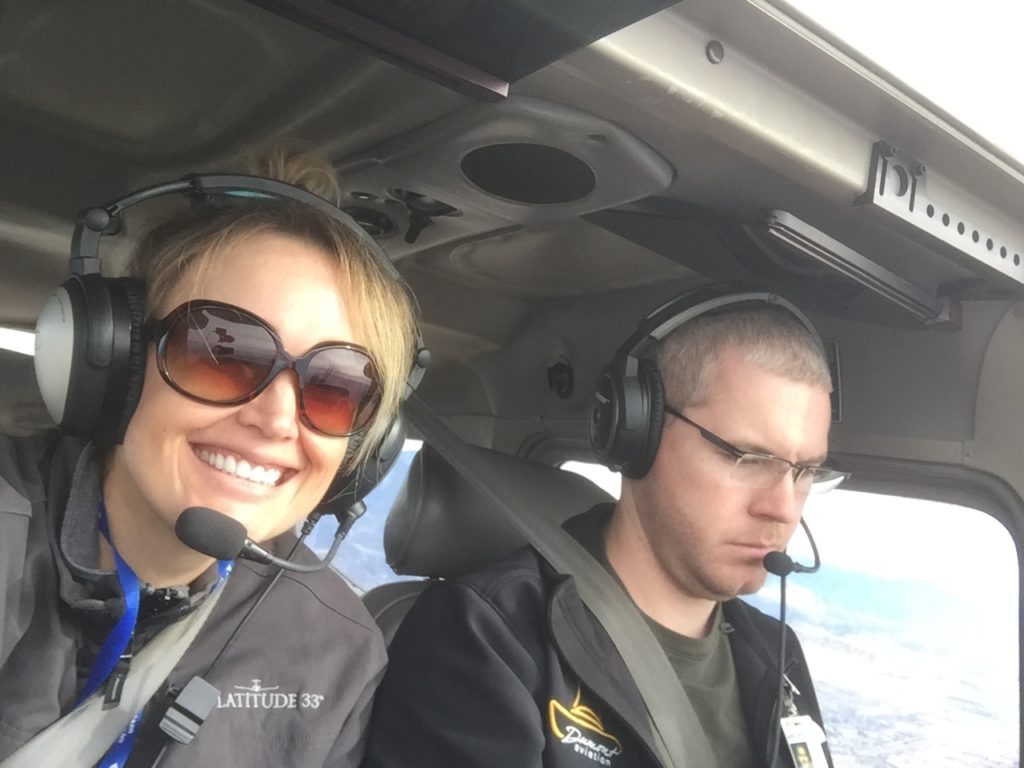Aircraft Dispatcher Exam: Lesson Two (Aerodynamics and Aircraft Systems) – Wing Lift Devices
Aerodynamics and Aircraft Systems – Wing Lift Devices
Do you know the difference between plain flaps and split flaps? Well, that’s just one of the topics you’re expected to know about this section of aerodynamics and aircraft systems. The questions on the ADX exam about slats, flaps, spoilers and so forth can all be grouped into wing lift devices. These question touch on the four forces of flight, especially drag and lift, and how changes to a wing configuration affects them.
Question 1. One method of boundary layer control is accomplished by injecting
a. jet of air into the leading edge to energize the boundary layer.
b. a low speed jet of air into the boundary layer.
c. a high speed jet of air into the boundary layer.
The correct answer is ‘a’- jet of air into the leading edge to energize the boundary layer. Boundary layer control devices create a lifting force on the surface of part of a wing. Injecting a high speed stream or jet of air (high pressure engine bleed air) into the boundary layer at higher angles of attack can delay a wing stall – and allow the wing to operate at higher angles of attack. Science!
Question 2. Leading-edge, high-lift devices are
a. more effective on the highly swept wing than trailing edge flaps.
b. less effective than a trailing edge device on a swept wing.
c. more effective than flaps because of the increase in drag at relatively low angles of attack.
The correct answer is ‘a’- more effective on the highly swept wing than trailing edge flaps. In other words, they are more effective at creating additional lift than trailing edge flaps. Trailing edge flaps cause more drag than lift, especially when fully deployed.
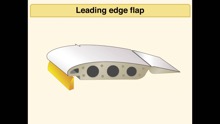
Question 3. What is the purpose of ground spoilers?
a. Increase the rate of descent without gaining airspeed.
b. Aid in rolling an airplane into a turn.
c. Reduce the wings’ lift upon landing.
The correct answer is ‘c’- Reduce the wings’ lift upon landing. This is perhaps the easiest question in the bunch, because the first two answers don’t do anything on the ground. Ground spoilers work on the ground, working by destroying the wings’ lift and transferring the weight of the aircraft to the wheels.
Question 4. What is the primary function of the leading edge flaps in landing configuration during the flare before touchdown?
a. Decrease rate of sink.
b. Prevent flow separation.
c. Increase profile drag.
The correct answer is ‘b’- Prevent flow separation. Leading edge flaps change the camber (curve) of the wing which helps prevent flow separation at higher angles of attack, like what would be encountered during the flare.
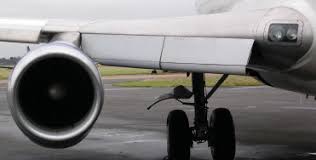
Question 5. Which is a purpose of leading edge slats on high-performance wings?
a. Improve aileron control during low angles of attack.
b. Increase lift at relative slow speeds.
c. Direct air from the low pressure area under the leading edge along the top of the wing.
The correct answer is ‘b’- Increase lift at relative slow speeds. From the PHAK (Chapter 5), we know that leading-edge slats are “high lift devices” – they are extended at lower speeds to increase lift.
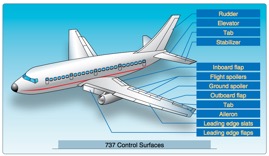
Question 6. Upon landing, spoilers
a. decrease directional stability on the landing rollout.
b. function by increasing ground to tire friction.
c. should be extended after the thrust reversers have been deployed.
The correct answer is ‘b’- function by increasing ground to tire friction. This question follows the same vein as Question 3 re the purpose of ground spoilers. Deploying spoilers on landing destroys the wing’s lift, transferring additional weight to the main breaks, which in turn increases friction between the tires and the ground.
Question 7. Which is the purpose of leading-edge slats on high-performance wings?
a. Direct air from the high pressure area under the leading edge along the top of the wing.
b. Improve aileron control during low angles of attack.
c. Decrease lift at relative slow speeds.
The correct answer is ‘a’ – Direct air from the high pressure area under the leading edge along the top of the wing. This is another question out of PHAK Chapter 5. Opening/extending the slats allows air from under the wing to flow over the wing’s upper surface. This delays airflow separation.
Question 8. When compared to plain flaps, split flaps
a. produce more lift with less drag.
b. produce only slightly more lift, but much more drag.
c. enhance takeoff performance in high density conditions.
The correct answer is ‘b’ – produce only slightly more lift, but much more drag.
Not all flaps are created equal. The easiest way for me to remember this question is to remember that split flaps produce more lift and MORE drag. They only produce slightly more lift than regular flaps, though. The additional drag is substantial, due to the panels that droop from the undersides of the wing. Split flaps are less common these days, and were common in WW-II era flighter planes, and also in DC-3 aircraft.
Question 9. Fowler flaps as compared to split flaps
a. generate more nose down pitching moment.
b. develop much more drag.
c. cause very little change in the airplane structure.
The correct answer is ‘a’ – generate more nose down pitching moment. The double-slotted Fowler flap creates two gaps as the flaps deploy, allowing more air to leak through two slots to the top surface and increase lift. Fowler flaps generate the biggest change in pitching moment (compared to the split flap, which causes the least change).
Question 10. For which purpose may flight spoilers be used?
a. Increase the rate of descent without increasing aerodynamic drag.
b. Reduce the wings’ lift upon landing.
c. Aid in longitudinal balance when rolling an airplane into a turn.
The correct answer is ‘b’ – Reduce the wings’ lift upon landing. This question can be grouped with questions 3 and 6. Spoilers work when the plane lands. Using spoilers upon landing destroys the wings’ lift, and makes the wheel brakes more effective.
Question 11. It is important to combine the boundary layer control with flaps since
a. the flap deflection tends to reduce the angle of attack to maximize lift.
b. the flap deflection tends to increase the angle of attack for maximum lift.
c. the boundary layer controls are only effective at low power settings.
The correct answer is ‘a’ – the flap deflection tends to reduce the angle of attack to maximize lift. Boundary layer separation is generally undesirable in aircraft high lift coefficient systems and jet engine intakes. Boundary layer control devices combined with flaps maintain high velocity smooth airflow with maximum lift capability.
Question 12. On which type of wing are flaps most effective?
a. Thin wing.
b. Thick wing.
c. Sweptback wing.
The correct answer is ‘b’ – Thick wing. Thinner and swept back wing reduce the effectiveness of flaps (due to reduction of lift).
Question 13. The first 50% of flap deflection causes
a. more than half of the total change in drag.
b. more than half of the total change in lift.
c. very little affect on lift.
The correct answer is ‘b’ – more than half of the total change in LIFT. Then – the remaining 50% of flap deflection provides over 50% of the total DRAG increase from the flaps.
Question 14. The primary purpose of high-lift devices is to increase the
a. drag and reduce airspeed.
b. L/Dmax.
c. lift at low speeds.
The correct answer is ‘c’ – lift at low speeds. This is another one of those questions where the answer is right there in the question. Remember – High lift devices increase lift. In other words, when high-lift devices are extended, lift is extended to allow lower speed flight.
Question 15. What effect does the leading edge slot in the wing have on performance?
a. Decelerates the upper surface boundary layer air.
b. Changes the stalling angle of attack to a higher angle.
c. Decreases profile drag.
The correct answer is ‘b’ – Changes the stalling angle of attack to a higher angle. The slots in the leading edge direct airflow to the upper wing surface, which delays separation of airflow and allows the plane to fly at a higher angle of attack without stalling.
Question 16. What is the purpose of leading edge flaps?
a. Reduce lift without increasing airspeed.
b. Increase the camber of the wing.
c. Direct airflow over the top of the wing at high angles of attack.
The correct answer is ‘b’ – Increase the camber of the wing. Increasing the curve of the wing provides more lift at a given airspeed.
Question 17. What is the difference between the Fowler flap system and the split flap system?
a. Fowler flaps produce more drag.
b. Fowler flaps produce the greatest change in pitching moment.
c. Split flaps cause the greatest change n twisting loads.
The correct answer is ‘b’ – Fowler flaps produce the greatest change in pitching moment. A fowler flap is a split flap that slides backwards, before hitching downward.
Question 18. The tucking (downward motion) of the nose of an airplane during extension of Fowler flaps is
a. a sign of contamination and a no flap landing may be necessary.
b. normal.
c. abnormal.
The correct answer is ‘b’ – normal. Fowler flaps cause the greatest change in twisting moment, which causes the nose of an aircraft to “tuck”.
Question 19. What is the purpose of flight spoilers?
a. Reduce lift without increasing airspeed.
b. Increase the camber of the wing.
c. Direct airflow of the top of the wing at high angles of attack.
The correct answer is ‘a’ – Reduce lift without increasing airspeed. The purpose of spoilers is to destroy lift without an increase in airspeed.
Question 20. Compared to a straight wing, swept wing flaps are
a. as effective.
b. less effective.
c. more effective.
The correct answer is ‘b’ – less effective. Flaps lose their effectiveness on swept wing aircraft.
If you want to review these topics more, I highly recommend a review of PHAK Chapter 5. Happy studying!
Aircraft Dispatcher Exam: Lesson One — Aerodynamics and Aircraft Systems — Ailerons, Flight Controls and Trim Tabs
One of my 2018 goals that I know of already is to become a licensed aircraft dispatcher. The aircraft dispatcher exam (ADX) shares many of the same questions as the airline transport pilot (ATP) exam, as thirteen areas for testing are identical. In preparation for 2017 rolling into 2018, I will be posting a series of blog post lessons, which will include 10-20 questions each, the correct answers, and some discussion and explanations.
Aerodynamics and Aircraft Systems – Overview of Subsections
The Aerodynamics and Aircraft Systems section covers a lot of topics, called subsections. Some of the questions may be basic private pilot stuff, but there are questions on turbine engine systems, de-ice, anti-ice, glass cockpit systems and more. Below is the list of subsections and the number of questions in my question bank:
- Ailerons, Flight Controls and Trim Tabs (14 questions)
- Wing Lift Devices (20 questions)
- Lift and Drag (20 questions)
- Stall Speeds (14 questions)
- Load Factor (6 questions)
- Turns and Climbs (11 questions)
- Stability and Loading (13 questions)
- Takeoff and Landing Performance (14 questions)
- Maximum Range (7 questions)
- Propeller Pitch, Engine Performance and Turbochargers (6 questions)
- Multi-Engine Airplane Operation (14 questions)
- Turbine-Engine Operation (11 questions)
- Compressor Stall (5 questions)
- Mach Flight (12 questions)
- Hydroplaning (8 questions)
- Thrust Reversers (3 questions)
- Aircraft Icing and Performance, De-icing, Anti-icing (20 questions)
- Pitot-static and Altimeter Systems (5 questions)
- Glass Cockpit Systems (9 questions)
Aerodynamics and Aircraft Systems – Ailerons, Flight Controls and Trim Tabs
Question 1. What is the purpose of the servo tab?
a. Move the flight controls in the event of manual reversion.
b. Reduce control forces by deflecting the proper direction to move a primary flight control.
c. Prevent a control surface from moving to a full deflection position due to aerodynamic forces.
The correct answer is ‘b’ – Reduce control forces by deflecting the proper direction to move a primary flight control. Servo tabs reduce control forces by deflecting in the proper direction to move a primary flight control. You can read more about servo tabs on Wikipedia.
Question 2. When are inboard ailerons normally used?
a. Low-speed flight only.
b. High-speed flight only.
c. Low-speed and high speed flight.
The correct answer is ‘c’ – Low speed and high-speed flight. I don’t know the point of this question, but I guess that makes the answer easy to remember (for me). The question is there, I suppose, because some commercial aircraft have inboard ailerons, and some don’t. Airbus aircraft do not have inboard ailerons because they move the flaps differently (straight back as opposed to perpendicular to the hingeline, like a Boeing).
Question 3. Precise roll control using a rudder on a transport category airline
a. can be effective when turbulence is encountered.
b. is difficult and therefore not recommended.
c. should be considered to assist the yaw damper.
The correct answer is ‘b’ – is difficult and therefore not recommended. Remember that differential lift for roll control is typically obtained by some type of ailerons or spoilers movement. Rudder is used to control yaw about the vertical axis. Using rudders primarily to achieve roll control can contribute to dihedral effect, which can lead to a few problems, including the tailwagging, side-to-side dutch roll. In jets, we use a yaw damper to increase stability and prevent these tendencies.
Question 4. Which direction from the primary control surface does an elevator adjustable trim tab move when the control surface is moved?
a. Remains fixed for all positions
b. Opposite direction.
c. Same direction
The correct answer is ‘a’- Remains fixed for all positions. This question seemed like basic common sense for me, so I was able to come up with the answer immediately. Trim tabs remain in a fixed position relative to the control surface.
Question 5. Which direction from the primary control surface does a servo tab move?
a. Opposite direction.
b. Same direction.
c. Remains fixed for all positions.
The correct answer is ‘a’ – Opposite direction. Servo tabs work to reduce the control forces required from the pilot, and move in the opposite direction from the primary control surface.
Question 6. When are outboard ailerons normally used?
a. High-speed flight only.
b. Low-speed flight only.
c. Low-speed and high-speed flight.
The correct answer is ‘b’ – Low-speed flight only. To remember the answer to this question, I think about this little diagram I found on the internet. The outboard aileron is called the low speed aileron. Don’t get confused though, remember question 2? Inboard ailerons are used for low-speed and high speed flight.
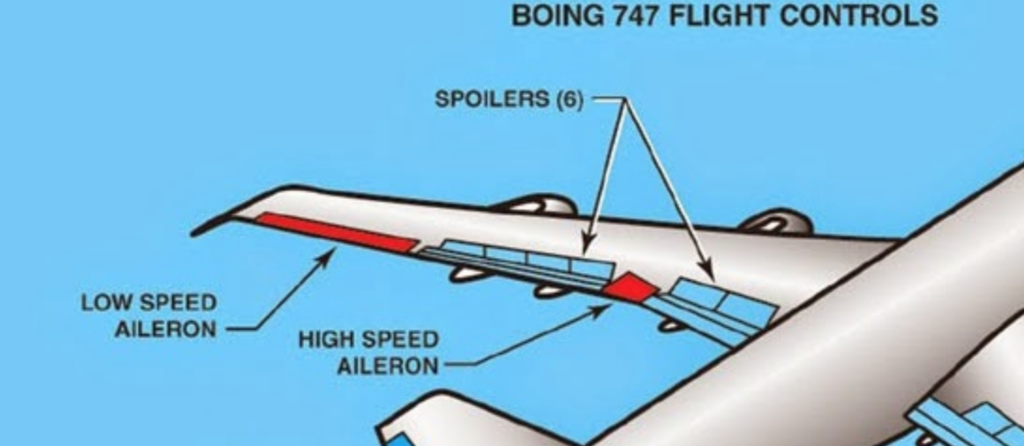
Question 7. Which of the following is considered an auxiliary flight control?
a. Upper rudder.
b. Ruddervator
c. Leading-edge flaps.
The correct-answer is ‘c’- Leading-edge flaps. I have never flown a V-tail airplane, so I had never heard of a “ruddervator” until this study session, but it is a hybrid of elevator and rudder, both primary flight controls. I’ve also never flown a split rudder airplane, but again, I know that rudders are primary flight controls. Flaps are NOT primary flight controls, they are secondary (along with trim devices). In the case of this question, auxiliary means the same thing as secondary. Leading edge flaps ae secondary or auxiliary flight controls.
Question 8. Which direction from the primary control surface does anti-servo tab move?
a. Remains fixed for all positions.
b. Same direction.
c. Opposite direction.
The correct answer is ‘b’ – Same direction. The key to answering this question correctly is reading it closerly. The Pilot’s Handbook of Aeronautical Knowledge (PHAK) says in chapter Five that anti-servo tabs move in the same direction as the primary control service.
Question 9. What is the purpose of an anti-servo tab?
a. Move the flight controls in the event of manual reversion.
b. Reduce control forces by deflecting in the proper direction to move a primary flight control.
c. Prevent a control surface from moving to a full-deflection position due to aerodynamic forces.
The correct-answer is ‘c’- Prevent a control surface from moving to a full-deflection position due to aerodynamic forces. Another question right out of PHAK, Chapter 5. Anti-servo tabs work to decrease the sensitive of the control surface, and preventing a surface from moving to a full-deflection position.
Question 10. Why do some airplanes equipped with inboard/outboard ailerons use the outboards for slow flight only?
a. Increased surface area provides greater controllability with flap extension.
b. Aerodynamic loads on the outboard ailerons tend to twist the wingtips at high speeds.
c. Locking the outboard ailerons in high-speed flight provides for variable flight control feel.
The correct answer is ‘b’ – Aerodynamic loads on the outboard ailerons tend to twist the wingtips at high speeds. This goes back to the diagram in question 6. On planes with both inboard and outboard ailerons (Boeings), the outboard ailerons tend to be locked into the neutral position during high-speed flight to avoid twisting the wingtips. This isn’t a real concern at lower speeds.
Question 11. What is the purpose of a control tab?
a. Reduce control forces by deflecting in the proper direction to move a primary flight control.
b. Prevent a control surface from moving to a full-deflection position due to aerodynamic forces.
c. Move the flight controls in the event of manual reversion.
The correct-answer is ‘c’- Move the flight controls in the event of manual reversion. Control tabs are linked directly to the pilot controls.
Question 12. Which of the following is considered a primary flight control?
a. Dorsal fin.
b. Elevator.
c. Slats.
The correct answer is ‘b’ – a question straight out of the Private Pilot Exam! This was an easy one – straight out of PHAK chapter 5.
Question 13. What is the purpose of an elevator trim tab?
a. Modify the downward tail load for various airspeeds in flight eliminating the flight-control pressures.
b. Provide horizontal balance as airspeed is increased to allow hands-off flight.
c. Adjust the speed tail load for different airspeeds in flight allowing neutral control forces.
The correct answer is ‘a’- Modify the downward tail load for various airspeeds in flight eliminating the flight-control pressures. The answer to this question was simple to me, as I know from flying the Cessna, the elevator trim tab holds the elevator in proper position so that the pilot doesn’t need to put control pressure on the plane the whole flight.
Question 14: Which of the following are considered primary flight controls.
a. Tabs.
b. Flaps.
c. Outboard ailerons.
The correct-answer is ‘c’- Outboard ailerons. I know from my private pilot lessons that primary flight controls are elevators, ailerons, and rudders. This question is obviously designed to trick people who remember that not all planes have outboard ailerons. But it doesn’t matter. Tabs and flaps are not primary flight controls, and ailerons are primary flight controls (inboard or outboard).


